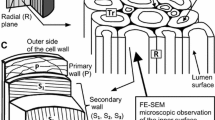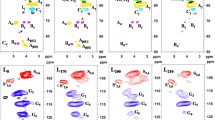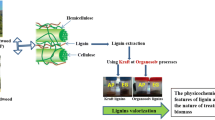Abstract
A standard two-step dilute sulfuric acid pretreatment was performed on Loblolly pine to enhance the overall efficiency of enzymatic deconstruction of woody biomass to monomeric sugars. The structure of milled wood lignin and cellulose isolated from the untreated and acid-treated biomass was studied in detail. Solid-state 13C NMR spectroscopy coupled with line shape analyses has been employed to elucidate cellulose crystallinity and ultrastructure. The results indicate an increase in the degree of crystallinity and reduced relative proportion of less ordered cellulose allomorphs following the acid pretreatment. This increase was attributed to a preferential degradation of amorphous cellulose and less ordered crystalline forms during the high temperature pretreatment. Milled wood lignin structural elucidation by quantitative 13C and 31P NMR reveals an increase in the degree of condensation of lignin due to the pretreatment. The increase in degree of condensation is accompanied by a decrease in β-O-4 linkages which were fragmented and recondensed during the high temperature acid-catalyzed reactions.





Similar content being viewed by others
Abbreviations
- CP/MAS:
-
Cross polarization/ Magic angle spinning
- CrI:
-
Crystallinity index
- DM:
-
Dry matter
- MWL:
-
Milled wood lignin
- NMR:
-
Nuclear magnetic resonance
- SEM:
-
Scanning electron microscope
References
Galbe M, Zacchi G (2002) A review of the production of ethanol from softwood. Appl Microbiol Biotechnol 59:618–628
Mabee WA, Gregg DJ, Arato C et al (2006) Updates on softwood-to-ethanol process development. Appl Biochem Biotechnol 129–132:55–70
Ragauskas AJ, Nagy M, Kim DH et al (2006) From wood to fuels, integrating biofuels and pulp production. Ind Biotechnol 2:55–65
Ragauskas AJ, Williams CK, Davison BH et al (2006) The path forward for biofuels and biomaterials. Science 311:484–489
Ramos LP (2003) The chemistry involved in the steam treatment of lignocellulosic materials. Qium Nova 26:863–871
Zhang Y-HP, Lynd LR (2004) Toward an aggregated understanding of enzymatic hydrolysis of cellulose:Noncomplexed cellulase systems. Biotechnol Bioeng 88:797–824
Pu Y, Zhang D, Singh PM et al (2008) The new forestry biofuels sector. Biofuels, Bioproducts, Biorefining 2:58–73
Davis MF, Ishizawa C, Jeoh T et al (2007) Chemical and physical properties of pretreated biomass that affect enzyme accessibility and digestibility. in 233rd ACS National Meeting. 2007. American Chemical Society, Chicago, IL
Willfor S, Sundberg A, Hemming J et al (2005) Polysaccharides in some industrially important softwood species. Wood Sci Technol 39:245–258
Willfor S, Sundberg A, Pranovich A et al (2005) Polysaccharides in some industrially important hardwood species. Wood Sci Technol 39:601–617
Sjostrom E (1993) Wood chemistry. Academic, San Diego
Atalla RH, VanderHart DL (1984) Native cellulose: a composite of two distinct crystalline forms. Science 223:283–285
Sugiyama J, Persson J, Chanzy H (1991) Combined infrared and electron diffraction study of the polymorphism of native celluloses. Macromolecules 24:2461–2466
Sugiyama J, Vuong R, Chanzy H (1991) Electron diffraction study on the two crystalline phases occurring in native cellulose from an algal cell wall. Macromolecules 24:4168–4175
Larsson PT, Westermark U, Iverson T (1995) Determination of the cellulose I alpha allomorph content in a tunicate cellulose by CP/MAS 13C-NMR spectroscopy. Carbohydr Res 278:339–343
Larsson PT, Wickholm K, Iverson T (1997) A CP/MAS 13C NMR investigation of molecular ordering in celluloses. Carbohydr Res 302:19–25
Larsson S, Palmqvist E, Hagerdal-Hahn B et al (1999) The generation of fermentation inhibitors during dilute acid hydrolysis of softwood. Enzyme Microb Technol 24:151–159
Lennholm H, Larsson PT, Iverson T (1994) Determination of cellulose I alpha and I beta in lignicellulosic materials. Carbohydr Res 261:119–131
Pu Y, Ziemer C, Ragauskas AJ (2006) CP/MAS 13C NMR analyses of cellulase treated bleached softwood kraft pulp. Carbohydr Res 341:591–597
Wickholm K, Hult E-L, Larsson PT et al (2001) Quantification of cellulosic forms in complex cellulosic materials: a chemometric model. Cellulose 8:139–148
Wickholm K, Larsson PT, Iverson T (1998) Assignment of non-crystalline forms in cellulose I by CP/MAS 13C NMR spectroscopy. Carbohydr Res 312:123–129
Converse AO (1993) Substrate factors limiting enzymatic hydrolysis. In: Saddler JN (ed) Bioconversion of forest and agricultural plant residues. CAB, Wallingford, pp 93–106
Lynd LR, Weimer PJ, van Zyl WH et al (2002) Microbial cellulose utilization: fundamentals and biotechnology. Microbiol Mol Biol Rev 66:506–577
Mansfield SD, Mooney C, Saddler JN (1999) Substrates and enzyme characteristics that limit cellulose hydrolysis. Biotechnol Progr 15:804–816
Cao Y, Tan H (2005) Study on crystal structures of enzyme-hydrolyzed cellulosic materials by X-ray diffraction. Enzyme Microb Technol 36:314–317
Ohmine K, Ooshima H, Harano Y (1983) Kinetic study of enzymatic hydrolysis of cellulose by cellulase from Trichoderma viride. Biotechnol Bioeng 25:2041–2053
Puls J, Wood TM (1991) The degradation pattern of cellulose by extracellular cellulases of aerobic and anaerobic microorganisms. Bioresour Technol 36:15–19
Sinitsyn AP, Mitkevich OV, Gusakov AV (1989) Decrease in reactivity and change of physico-chemical parameters of cellulose in the course of enzymatic hydrolysis. Carbohydr Polym 10:1–14
Mosier N, Wyman C, Dale B et al (2005) Features of promising technologies for pretreatment of lignocellulosic biomass. Bioresour Technol 96:673–686
Nguyen QA, Tucker MP, Keller FA (2000) Two-stage dilute-acid pretreatment of softwoods. Appl Biochem Biotechnol 84–86:561–576
Tengborg C, Galbe M, Zacchi G (2001) Influence of enzyme loading and physical parameters on the enzymatic hydrolysis of steam-pretreated softwood. Biotechnol Prog 17:110–117
Boussaid A, Robinson J, Cai Y et al (1999) Fermentability of the hemicellulose derived sugars from steam exploded softwood (Douglas-Fir). Biotechnol Bioeng 64:284–289
Soderstrom J, Pilcher L, Galbe M et al (2002) Two-step pretreatment of softwood with SO2 impregnation for ethanol production. Appl Biochem Biotechnol 98–100:5–21
Wu MM, Chang K, Gregg DJ et al (1999) Optimization of steam explosion to enhance hemicellulose recovery and enzymatic hydrolysis of cellulose in softwoods. Appl Biochem Biotechnol 77–79:47–54
Kim TH, Lee YY (2005) Pretreatment of corn stover by soaking in aqueous ammonia. Appl BiochemBiotechnol 121–124:1119–1132
Soderstrom J, Galbe M, Zacchi G (2005) Separate versus simultaneous saccharification and fermentation of two-step steam pretreated softwood for ethanol production. J Wood Chem Technol 25:187–202
Soderstrom J, Pilcher L, Galbe M et al (2003) Two-step steam pretreatment of softwood by dilute H2SO4 impregnation for ethanol production. Biomass Bioenergy 24:475–486
Pan X, Gilkes N, Kadla JF et al (2006) Bioconversion of hybrid poplar to ethanol and co-products using an organosolv fractionation process: optimization of process yields. Biotechnol Bioeng 94:851–861
Pan X, Xie D, Yu R et al (2007) Biorefining of Lodgepole pine killed by mountain pine beetle using ethanol organosolv process: fractionation and process optimization. Ind Eng Chem Res 46:2609–2617
Soderstrom J, Galbe M, Zacchi G (2004) Effect of washing on yield in one and two step steam pretreatment of softwood for production of ethanol. Biotechnol Prog 20:744–749
Frederick WJ, Lien SJ, Courchene CE, DeMartini NA, Ragauskas AJ, Iisa K (2008) Production of ethanol from carbohydrates from loblolly pine: A technical and economic assessment. Bioresour Technol 99(11):5051–5057
Lin S, Dence C (eds) (1992) Methods in lignin chemistry. Springer series in wood science. Springer, Berlin, 578 pp
Sjostrom E, Alen R (1998) Analytical methods in wood chemistry, pulping and paper making. In: Timmel TE (ed) Springer series in wood science. Springer, Berlin, p 315
Hult E-L, Larsson PT, Iverson TA (2000) Comparative CP/MAS 13C NMR study of cellulose structure in spruce wood and kraft pulp. Cellulose 7:35–55
Guerra A, Mendonca R, Ferraz A et al (2004) Structural characterization of lignin during Pinus taeda wood treatment with Ceriporiopsis subvermispora. Appl Environ Microbiol 70:4073–4078
Holtman KM, Cheng H-M, Jameel H et al (2006) Quantitative 13C NMR characterization of milled wood lignins isolated by different milling techniques. J Wood Chem Technol 26:21–34
Robert D (1992) Carbon-13 nuclear magnetic resonance spectroscopy. In: Lin S, Dence C (eds) Methods in lignin chemistry. Springer, Berlin
Granata A, Argyropoulos DS (1995) 2-chloro-4,4,5,5-tetramethyl-1,3,2-dioxaphospholane, a reagent for the accurate determination of the uncondensed and condensed phenolic moieties in lignins. J Agric Food Chem 43:1538–1544
Li J, Henriksson G, Gellerstedt G (2005) Carbohydrate reactions during high-temperature steam treatment of aspen wood. Appl Biochem Biotechnol 175:175–187
Li J, Henriksson G, Gellerstedt G (2007) Lignin depolymerization/repolymerization and its critical role for delignification of aspen wood by steam explosion. Bioresour Technol 98:3061–3068
Ibbett RN, Domvoglou D, Fasching M (2007) Characterization of the supramolecular structure of chemically and physically modified regenerated cellulosic fibres by means of high-resolution carbon-13 solid-state NMR. Polymer 48:1287–1296
Hult E-L, Liitia T, Maunu SL, Hortling B, Iversen T (2002) A CP/MAS 13C-NMR study of cellulose structure on the surface of refined kraft pulp fibers. Carbohydr Polym 49:231–234
Larsson PT, Hult E-L, Wickholm K, Pettersson E, Iverson T (1999) CP/MAS 13C-NMR spectroscopy applied to structure and interaction studies on cellulose I. Solid-state Nucl Magn Reson 15:31–40
Bergensträhle M, Wohlert J, Larsson PT, Mazeau K, Berglund L (2008) Dynamics of cellulose-water interfaces: NMR spin-lattice relaxation times calculated from atomistic computer simulations. J Phys Chem B 112:2590–2595
Holtman KM, Kadla JF (2004) A solution NMR study of the similarities between MWL and CEL. J Agric Food Chem 52:720–726
Zawadski M, Ragauskas AJ (2001) N-hydroxyl compounds as new internal standards for the 31P NMR determination of lignin hydroxyl functional groups. Holzforschung 55:283–285
Josefsson T, Lennholm H, Gellerstedt G (2001) Changes in cellulose supramolecular structure and molecular weight distribution during steam explosion of aspen wood. Cellulose 8:289–296
Debzi EM, Chanzy H, Sugiyama J et al (1991) The I-alpha to I-beta transformation of highly crystalline cellulose by annealing in various mediums. Macromolecules 24:6816–6822
Lindgren T, Edlund U, Iverson T (1995) A multivariate characterization of crystal transformations of cellulose. Cellulose 2:273–288
Acknowledgment
The authors wish to acknowledge financial support from Chevron Technology Ventures for these studies.
Author information
Authors and Affiliations
Corresponding author
Rights and permissions
About this article
Cite this article
Sannigrahi, P., Ragauskas, A.J. & Miller, S.J. Effects of Two-Stage Dilute Acid Pretreatment on the Structure and Composition of Lignin and Cellulose in Loblolly Pine. Bioenerg. Res. 1, 205–214 (2008). https://doi.org/10.1007/s12155-008-9021-y
Received:
Accepted:
Published:
Issue Date:
DOI: https://doi.org/10.1007/s12155-008-9021-y




